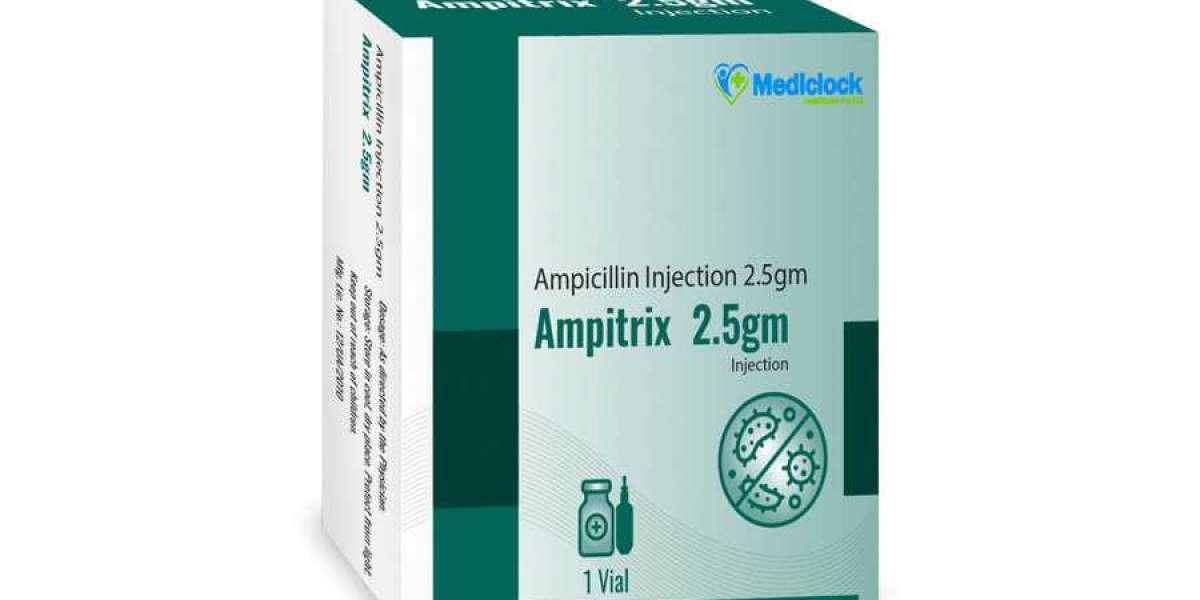Ampicillin injectable (vet.) suspension is a broad-spectrum penicillin used in veterinary medicine to treat various infections caused by susceptible strains of bacteria in dogs, cats, cattle, and calves. It has bactericidal activity against a wide range of common gram-positive and gram-negative bacteria. The medication is particularly indicated for respiratory tract infections, urinary tract infections, gastrointestinal infections, skin, soft tissue, and post-surgical infections in dogs, cats, cattle, and calves. Ampicillin for injectable suspension is administered either subcutaneously or intramuscularly, with dosages varying based on the type of infection and the animal's weight. It is essential to follow the prescribed dosage and administration instructions provided by a licensed veterinarian to ensure effective treatment and minimise the risk of side effects.
Overview of Ampicillin Injection (Vet.)
Ampicillin injection for veterinary use is a potent antibiotic belonging to the penicillin class. It is commonly used in veterinary medicine to combat bacterial infections in a variety of animals, including dogs, cats, cattle, and calves. This medication is a valuable tool in the veterinarian's arsenal for treating a broad spectrum of bacterial infections due to its efficacy against both gram-positive and gram-negative bacteria.
Indications for Use
- Respiratory Tract Infections: Ampicillin injection is often prescribed to address respiratory infections in animals, including pneumonia and bronchitis.
- Urinary Tract Infections: It can be effective in treating urinary tract infections caused by susceptible bacteria.
- Gastrointestinal Infections: Ampicillin is used to combat gastrointestinal infections such as enteritis and colitis.
- Skin and Soft Tissue Infections: In cases of skin wounds, abscesses, or other soft tissue infections, ampicillin can be a valuable treatment option.
- Post-Surgical Infections: Following surgical procedures, ampicillin may be administered to prevent or treat postoperative infections.
Administration and Dosage
- Route of Administration: Ampicillin for injectable suspension is typically administered subcutaneously or intramuscularly.
- Dosage: The dosage of ampicillin varies depending on the type and severity of the infection, as well as the weight of the animal being treated. It is crucial to follow the veterinarian's instructions regarding dosage and frequency of administration to ensure optimal treatment outcomes.
Mechanism of Action
Ampicillin works by inhibiting the synthesis of bacterial cell walls, leading to the destruction of susceptible bacteria. It interferes with the formation of peptidoglycan, a crucial component of the bacterial cell wall, ultimately causing the bacteria to weaken and die. This mechanism of action makes ampicillin effective against a wide range of bacterial pathogens.
Considerations and Precautions
- Allergic Reactions: Animals with known hypersensitivity to penicillins should not receive ampicillin.
- Bacterial Sensitivity: Prior to treatment, it is advisable to conduct bacterial culture and sensitivity tests to ensure the effectiveness of ampicillin against the specific infecting organism.
- Duration of Treatment: Completing the full course of treatment is essential to prevent the development of antibiotic resistance.
Extended Use and Benefits of Ampicillin Injection (Vet.)
Extended Use:
- Mastitis: Ampicillin is commonly used in dairy cattle to treat mastitis, an inflammatory condition of the udder caused by bacterial infection. Its broad-spectrum activity makes it effective against the diverse range of bacteria that can cause mastitis.
- Reproductive Tract Infections: In breeding animals, ampicillin can be employed to address reproductive tract infections, such as metritis or pyometra, helping to restore reproductive health.
- Joint Infections: Ampicillin may also be indicated in cases of septic arthritis or other joint infections in animals, where prompt antibiotic therapy is crucial to prevent further complications.
Benefits:
- Cost-Effective Treatment: Ampicillin is a cost-effective antibiotic option for veterinarians, providing effective treatment at a reasonable cost.
- Rapid Onset of Action: Due to its bactericidal nature, ampicillin can quickly start combating bacterial infections, offering rapid relief to the animal.
- High Efficacy: With its broad spectrum of activity, ampicillin is effective against a wide range of bacterial pathogens, making it a versatile choice for various infections.
- Well-Established Safety Profile: Ampicillin has been used in veterinary medicine for many years, and its safety profile is well-documented, providing reassurance to veterinarians and pet owners alike.
Proper Storage and Handling
To maintain the efficacy of ampicillin injection for veterinary use, it is essential to store the medication correctly. Ampicillin should be stored in a cool, dry place away from direct sunlight and at the recommended temperature as specified by the manufacturer. Additionally, proper handling practices, such as using sterile equipment for administration and following aseptic techniques, are crucial to prevent contamination and ensure the medication's effectiveness.
Future Considerations and Research
As antibiotic resistance continues to be a significant concern in veterinary medicine, ongoing research into the optimal use of antibiotics like ampicillin is essential. This includes exploring strategies to minimise the development of resistance, such as appropriate dosing regimens, combination therapies, and surveillance of bacterial susceptibility patterns. Additionally, further studies on the pharmacokinetics and pharmacodynamics of ampicillin in different animal species can help refine treatment protocols and enhance therapeutic outcomes.
Side Effects
While generally well-tolerated, ampicillin can cause side effects in some animals. Common side effects may include gastrointestinal disturbances such as diarrhoea or vomiting. In rare cases, allergic reactions such as skin rashes or anaphylaxis may occur. If any adverse reactions are observed, it is crucial to discontinue the medication and seek veterinary advice promptly.
Conclusion
Ampicillin injection for veterinary use is a valuable antibiotic that plays a crucial role in the treatment of bacterial infections in a variety of animals. By understanding its indications, proper administration, mechanism of action, precautions, and potential side effects, veterinarians can effectively utilise ampicillin to combat infections and promote the health and well-being of their animal patients.













